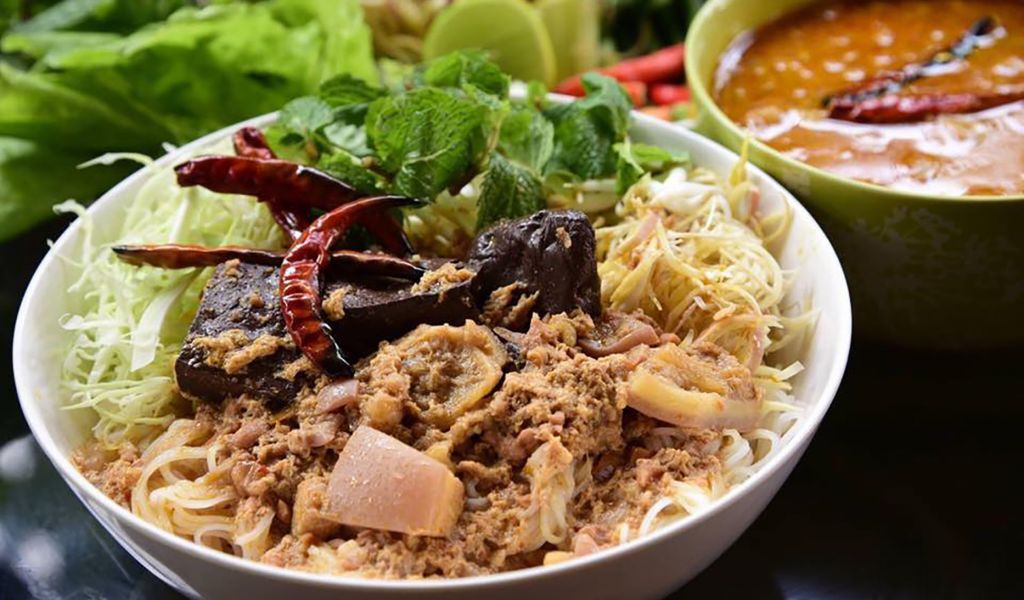ເຂົ້າປຸ້ນ / Rice noodle with spicy broth

Ingredients
• 500 g (1 lb) fish, rinsed and scaled if needed
• 1 kg (2 lb) meaty pork bones (or meaty chicken carcasses), washed
• 2 l (4 pt) water
• 2 t salt
• 1 stem lemongrass, knotted
• 1 small head garlic, top sliced off
• 1 onion (or 6 shallots), peeled and roughly chopped
• 6 slices galangal (or use ginger)
• 3 large stems coriander, knotted together
• 3 spring onions, each tied in a knot
• 2 T padek (or fish sauce) to taste
• 300 g (9 oz) blood cake cut in 2.5 cm (1 in) cubes, rinsed (optional)
• 300 g (9 oz) pork, minced
• 2 t red chilli powder (or to taste)
• 3 C coconut milk (optional)
Accompaniments
• 2 layers (1 kg/2 lb) fresh kao poon noodles (or dried kao poon or rice vermicelli noodles)
• Choose from the tastiest vegetables available. Have a mix - ture of colours and textures. These are suggestions.
• Arrange all on a platter for diners to help themselves.
• ½ unripe papaya or one carrot, shredded
• ½ banana flower, shredded 1 wedge of cabbage, shredded
• ½ cup cooked bamboo shoot, chopped
• 6 spring onions, finely chopped
• 1 cup bean sprouts
• 1 cup mint sprigs
• 1 cup yard-long beans, chopped
• 6 or more lime pieces, for squeezing
• 6 or more fried, dried chillies, finely pounded or whole
Serves six generously.
Method
1. In a large pot, bring the water to the boil. Add salt, lemongrass, garlic, onion, galangal, coriander and spring onions. Bring back to the boil and add the pork bones. Simmer and skim foam as it comes to the surface. Add the fish and fish sauce.
2. When the fish is cooked, remove it from the broth. Set aside to cool. Continue to simmer the broth until the pork can be easily separated from the bones (about 1 hour after coming to the boil).
3. Separate the pork bones from the broth. Strain the broth, setting aside any galangal, onion, shallot or garlic pieces. Discard any residue. Wash the pot.
4. Return the broth to the clean pot to simmer longer.
5. Add the cubes of blood cake. When they rise to the top of the broth, remove them and set aside.
6. Separate the fish from the bones and mash the fish. Remove the meat from the pork bones and cut into small pieces. Add the mashed fish, pork pieces and the uncooked minced pork to the broth.
7. Squeeze out the garlic from the reserved garlic cloves. Pound the galangal, garlic paste, onion and shallots together with the chilli powder. If not using coconut milk, add the pounded mixture to the broth. Taste and add salt, fish sauce or padek to taste.
8. If using coconut milk, put it and the pounded mixture in a small saucepan. Simmer until fragrant and the oil has separated. Add to the broth and stir in. Taste. Add salt or fish sauce or padek if desired.
9. To prepare the kao poon noodles, refresh fresh skeins in cold water, cut into large pieces and arrange in overlapping layers on a plate. For dried noodles, put them in a bowl with plenty of boiling water. Use a fork or chopsticks to separate the noodles. Remove from the hot water and drain after about 3 minutes. Arrange on a platter as with fresh noodles, above.
10. Place the platters of vegetables and noodles on the table. For each diner, put a handful of noodles in a bowl and spoon hot broth over them. Diners then add other ingredients to individual taste and mix them all together before eating.
Variations
• This dish is traditionally made with a small amount of fish, a pig’s head, pig’s lung and three-layer pork. Coconut milk is not added in northern Laos
Information by Food from Northern Laos (The Boat Landing Cookbook)
Video by May Laos. Kitchen
